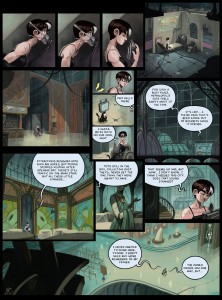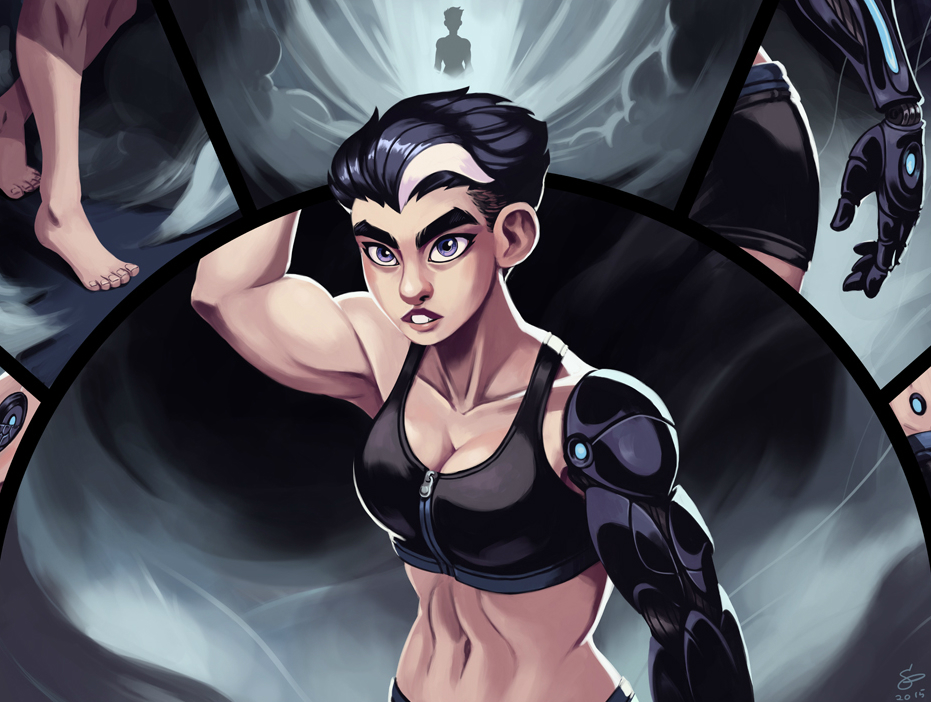In my last spotlight on Dresden Codak, I looked at the first five years of the strip and examined how artist and writer Aaron Diaz had developed through his early work and first storyline: Hob. It was a comic that hooked me initially with its quick-witted philosophical approach to science-fiction, and soon had me appreciating gorgeous art and impressively fluid page layouts. It gave me a lead character I truly admired in Kim Ross. Today, I’ll look at the storyline which makes up the latter half of the site’s output, Dark Science, and explore in depth a comic that continues to fascinate and inspire as Diaz pushes new boundaries in comic form.
Dark… Science? What Is This?

In Dark Science, we follow Kim Ross as she travels to Nephilopolis, a floating city built out of a World’s Fair on the literal shoulders of giants. The city is in the process of mourning the death of its architect, Kaito Kusanagi, who also happened to be Kim’s long-estranged father. In Nephilopolis, Kim is surrounded by forces and obstacles both foreign and eerily familiar. It’s a city where social interaction and career opportunity have been systemized to an oppressive degree, and Kim, genius-level roboticist but eternal outsider, finds herself at a loss of how to succeed in such an intrusive environment. Almost immediately after her arrival, Kim finds herself failing. Singled out and stumbling through the city’s shadows, Kim becomes embroiled in a dark conspiracy with ties to her own history and future.
The story involves worldbuilding on an epic scale. The art-deco aesthetics of Nephilopolis exemplify its vision with architecture, fashion, and culture all unique to Aaron Diaz’s world. Where some cities may have a Department of Water Treatment, Nephilopolis has the Department of Opposition. Where some have a Department of Finance, Nephilopolis has the Department of Inquisition. Populated by post-singularity cyborgs, cats with television heads, and an imposing bureaucratic authority, there’s no mistaking this location for anywhere else, especially not the small-town setting of Hob. Diaz cleverly handles the few inconsistencies with Hob by making it clear that the earlier storyline took place in a less developed part of his world, with Kim’s initial journey to Nephilopolis after a lifetime away being a moment of awe and wonder echoing of the feeling of expanding scale I got reading these opening pages for the first time.
Who Is This All About?
The use of supporting characters in Dark Science also shows Aaron Diaz’s growth as a storyteller as he broadens his scope to put emphasis on bigger stories and deeper worldbuilding through alternative perspectives within the story’s arc. Dark Science showcases characters like Vonnie and Balthazar, characters who stand so far above Hob’s Tokamak Twins in terms of having developed arcs of their own that a comparison hardly makes sense. Vonnie in particular has an arc that’s explored in earnest; starting off as the ultimate insider to counterpoint Kim’s outsider experiences, she finds herself not only disgraced as the story progresses, but spiralling downwards because of her unerring loyalty to the system. Thematically, this effort to tell the story through character rather than concept takes Dark Science to another tier. But it all comes back to Kim.
How Does It Look?
Creative panel layout is another signature aspect of any Dresden Codak page, with Diaz consistently attempting complicated patterns that push the reader to look at a page in untraditional ways. Every part of the page works together to tell the story, from the smallest interlocking panels to large artwork spread over the entire page. It all combines with extremely clear lettering to guide the reader’s eye. It is one of the greatest strengths of the comic as a whole and while Dresden Codak was already notably accomplished in this area, Dark Science is consistently masterful in its willingness to take creative risks.
Why Do You Care So Much?
Furthermore, and perhaps more importantly, the actual telling of the story supports a feminist reading in how Kim accomplishes her goals. Rather than putting Kim in situations of violence, Dark Science has Kim’s story take its cues from Intelligent Adventurers such as The Doctor and Characters of Heart like Mrs. Brisby in Don Bluth’s The Secret of NIMH. Kim uses both her mind and her inner emotional strength to work her way through obstacles in a compelling, rationally based narrative. The result is a storyline built less on violence and conflict, and more on figuring things out and choosing the power of one’s own will. It produces a more interesting, philosophical story and that’s why I’ve been so fond of Dresden Codak from the start.
But There’s Much Before Dark Science… Where Do I Start?
If you’d like to support Aaron Diaz, his current work has been primarily supported via Patreon, which allows him to put up a new page of Dark Science roughly once every two weeks. Patrons will gain access to exclusive content, progress reports on new pages as they are created, and is the best way to follow Dark Science as it continues.
